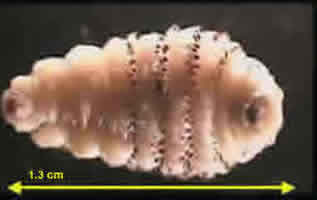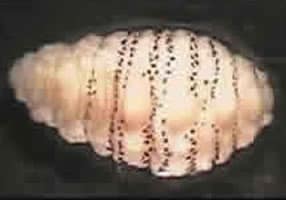
Monthy Case Studies - 1999
Case #19 - September, 1999
An adult man, who is very active outdoors, complained of a slow growing bump on his elbow. The patient excised the object and a small amount of fluid. He delivered it to a local Georgia hospital for identification and consultation. The object was sent to CDC for identification. What is your diagnosis? Based on what criteria?

Figure A

Figure B
Answer to Case #19
This was a case of myiasis caused by a bot fly larva in the family Oestridae (Dermatobia hominis or Cuterebra sp.). According to some authors, flies from the genus Hypoderma (family Hypodermatidae) are the most common cause of human myiasis in the United States. This particular case does not quite match that etiology in that those larvae tend to migrate from the original site. Identification to the species level is difficult and usually not necessary. However, one can use geographical data to attempt to place the larvae into a genus or family. Definitive identification relies on an experienced entomologist with access to applicable reference keys.
A brief synopsis of the life cycle of Dermatobia sp.: The adult bot fly oviposits on another insect (typically a mosquito). When the carrier insect later feeds on a host (human or other animal), the newly hatched bot fly larvae penetrate the host's skin at or near the bite area. The larvae continue their development inside a subdermal cavity. When mature, the larvae emerge and drop to the ground where they will pupate. After a month or so, the adult flies emerge to mate and begin the cycle over.
Treatment of myiasis consists of removal of the larvae (maggots), preferably by excision, and prevention/control of secondary infection.
More on: Myiasis
Images presented in the monthly case studies are from specimens submitted for diagnosis or archiving. On rare occasions, clinical histories given may be partly fictitious.
 ShareCompartir
ShareCompartir


